
Evaluation of Particulate Matter Deposition Efficiency and Air Quality Improvement by Vertical Shrub and Climber Walls
Pamon Pumas*Published Date : June 7, 2024
DOI : https://doi.org/10.12982/NLSC.2024.038
Journal Issues : Number 3, July-September 2024
Abstract Fine particulate matter poses a significant health risk indoors, making indoor air quality improvement crucial. Vertical greenery systems offer a promising solution, but selecting suitable plant species remains a challenge. This study evaluated the PM deposition and air quality impact of six ornamental plants (climbers and shrubs) in a controlled chamber. Almost all plants reduced CO2 by 20%, while PM deposition varied by species, with Petunia hybrid being the most efficient. Total leaf area showed the strong correlated with PM deposition. These findings confirm the potential of ornamental plants, particularly those with large total leaf area, for PM reduction in vertical greenery systems. Further research with a wider range of plants and advanced characterization techniques is needed to refine our understanding and develop practical guidelines for their effective use in indoor air purification.
Keywords: Particulate matter, Air quality, Vertical shrub, Climber walls
Funding: This research was financially supported by Chiang Mai Rajabhat University, Chiang Mai, Thailand. We acknowledge their generous contribution that enabled the execution of this study.
Citation: Pumas, P. 2024. Evaluation of particulate matter deposition efficiency and air quality improvement by vertical shrub and climber walls. Natural and Life Sciences Communications. 23(3): e2024038.
INTRODUCTION
Air pollution looms as a significant global challenge, fueled by diverse sources like vehicle emissions, industrial processes, agricultural burning and forest fires (Kawichai et al., 2021). Of particular concern is fine particulate matter (PM2.5), encompassing particles with diameters of 2.5 micrometers or less. These particles have been associated with a myriad of adverse health effects, including respiratory complications, allergies, and chronic illnesses such as cardiovascular disease and lung carcinoma (Pun et al., 2017; Manisalidis et al., 2020). Furthermore, PM2.5 possesses the ability to adsorb hazardous substances like polycyclic aromatic hydrocarbons (PAHs) (Kawichai et al., 2020). The World Health Organization has established a standard of 10 micrograms per cubic meter for PM2.5 concentrations within buildings (World Health Organization, 2021), emphasizing the need for effective strategies to address this threat before it infiltrates indoor spaces.
Indoor air quality plays a vital role in maintaining a healthy living and working environment. Therefore, continuous monitoring of these health effect parameters is crucial (Rabuan et al., 2023). This data is vital for advancing air pollution mitigation strategies and enhancing public health protection (Khaslan et al., 2024). Recognizing the limitations of outdoor air quality, indoor spaces offer opportunities for targeted interventions (Kelly and Fussell, 2019). Ornamental plants, including shrubs and climbers, emerge as promising tools for this purpose. Beyond their aesthetic appeal, these plants offer significant contributions to both indoor and outdoor air quality improvement (Perini and Rosasco, 2013).
Research has documented the multifaceted benefits of indoor plants, extending beyond air quality to encompass psychological well-being. Their presence creates calming and pleasant environments, leading to improved mood, reduced stress levels, and increased productivity (Abbasgholizadeh et al., 2021; Dzhambov et al., 2021; Ma, 2022). Additionally, plants play a vital role in mitigating climate change by actively absorbing carbon dioxide during photosynthesis (Panepinto et al., 2021).
Furthermore, specific plant species, particularly shrubs with small and delicate leaves, have shown effectiveness in filtering dust and absorbing various indoor air pollutants, including harmful substances released from building materials such as formaldehyde, benzene, trichloroethylene, and particulate matter (Bandehali et al., 2021; Treesubsuntorn et al., 2021). Utilizing such plants can contribute to a more sustainable and environmentally friendly living and working environment by improving indoor air quality while simultaneously reducing greenhouse gas emissions.
While significant progress has been made in understanding the role of ornamental plants in air quality improvement, research gaps remain. This study delves deeper by evaluating the efficiency of six plant species: three climbers (Clitoria ternatea L., Thunbergia grandiflora (Roxb. ex Rottler) Roxb, and Passiflora coccinea Aubl) and three shrubs (Tabernaemontana divaricata (dwarf), Lantana camara Linn., and Petunia hybrid). Controlled experiments within a closed chamber were conducted to precisely assess their capacity to deposit fine particulate matter and influence various physical and chemical air factors such as humidity, temperature, carbon dioxide, PM10, and PM2.5. Ultimately, this study aims to provide valuable insights for future air quality management strategies, particularly within vertical greenery systems, and contribute to fostering a greener and healthier living environment. By investigating both plant performance and the potential of using visual leaf characteristics as evaluation tools, this study has broader applications beyond scientific inquiry, benefiting public health and overall well-being, both indoors and outdoors.
MATERIALS AND METHODS
Plant preparation
Six plant species, comprising three climbers (Clitoria ternatea L., Thunbergia grandiflora (Roxb. ex Rottler) Roxb, and Passiflora coccinea Aubl) and three shrubs (Tabernaemontana divaricata (dwarf), Lantana camara Linn., and Petunia hybrid) (Figure 1.), were carefully procured from a reputable local Thai plant shop, Chiang Mai, Thailand, based on specific criteria with the aim of maximizing their efficiency in fine particulate matter reduction. Firstly, preference was given to small-sized leaves. Secondly, careful consideration was given to variations in leaf surface characteristics, including smooth, rough, and slightly hairy surfaces. Thirdly, a priority was placed on selecting shrub species that are readily available in the local region. The basic information of the plants used for testing is listed in Table 1.
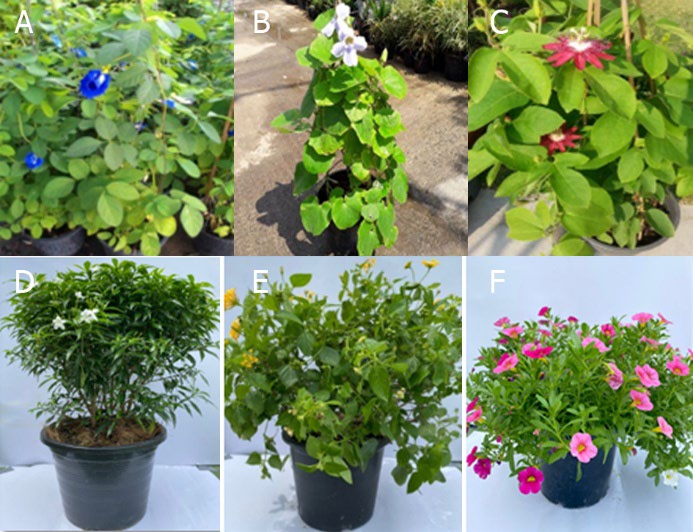
Figure 1. Visual appearance of the selected plants utilized in this research. A: Clitoria ternatea L., B: Thunbergia grandiflora (Roxb. ex Rottler) Roxb, C: Passiflora coccinea Aubl, D: Tabernaemontana divaricata (dwarf), E: Lantana camara Linn., F: Petunia hybrid.
Table 1. Basic characteristics of selected plants.
|
Plant species |
Characteristics of leave |
Average leaf area (cm2/leaf) |
Total leaf area in this experiment (m2) |
|
Clitoria ternatea |
The leaves of C. ternatea are arranged in an opposite pattern, resembling the structure of bird feathers, with 5-9 leaflets. The leaflets exhibit a lanceolate shape with pointed apices and smooth upper surfaces, while the lower leaf surfaces are adorned with small trichomes. This plant leaves are diminutive yet abundant. |
10.25 ± 7.25 |
0.89 |
|
Thunbergia grandiflora |
The individual leaves of T. grandiflora are arranged in an alternate fashion and have either heart-shaped or lanceolate morphology, possessing 5-7 prominent veins. These leaves measure 8-10 cm in width and 10-12 cm in length. The leaf apices are pointed, and the bases exhibit a heart-shaped contour with serrated margins. The leaf surface is characterized by a rough texture. |
38.17 ± 21.03 |
1.14 |
|
Passiflora coccinea |
The single leaves of P. coccinea exhibit an alternate arrangement, adopting either an egg-shaped or heart-shaped outline. They measure 7-10 cm in width and 14-18 cm in length. The leaf apices are pointed, and the bases display a wavy, heart-shaped configuration. These leaves are thick, green, and possess a covering of soft trichomes. |
26.14 ± 7.65 |
0.86 |
|
Tabernaemontana divaricata |
T. divaricate leaves are solitary and grow in pairs on opposite sides of the branch. These small leaves are lanceolate with pointed tips, exhibiting smooth surfaces devoid of trichomes. |
8.65 ± 5.24 |
34.67 |
|
Lantana camara |
The leaves of L. camara are arranged alternately, oppositely, or in pairs at right angles. The leaves are egg-shaped, characterized by pointed apices, serrated edges, and a rough texture due to the presence of small trichomes. |
7.84 ± 3.24 |
9.99 |
|
Petunia hybrid |
The leaves of Petunia are small-sized and entirely covered with trichomes. They take on an egg-shaped morphology with pointed apices and smooth edges. |
5.11 ± 3.99 |
72.47 |
The experimental setup was conducted under meteorological conditions in Thailand, with temperature ranging from 27.8 to 33.1 °C and relative humidity maintained between 60% and 90%. For the climber experiment, four 1-month-old specimens of each plant were transplanted into plastic pots. The plants were nurtured for a period of 2 months until they grew and effectively climbed on a trellis structure, measuring 1.00 meter in width and 1.50 meters in height, as depicted in Figure 2A. Regarding the shrub experiment, the plant height was controlled to remain within the range of 20 to 30 cm. Nine pots of each plant were suspended on a trellis, similar in dimensions to those used in the climber experiment (Figure 2E).

Figure 2. Experimental setup of plants utilized in the study. A: a schematic diagram illustrating the setup designed for the climbers, B: Clitoria ternatea L., C: Thunbergia grandiflora (Roxb. ex Rottler) Roxb, D: Passiflora coccinea Aubl, E: Schematic diagram representing the setup for shrub species, F: Tabernaemontana divaricata (dwarf), G: Lantana camara Linn., H: Petunia hybrid
Testing chamber and particulate matter generating
A closed-type simulated chamber was constructed with dimensions of 1.00 meter in width, 1.50 meters in height, and 2.00 meters in length, utilizing 18-millimeter PVC pipes interconnected by 3-way PVC connectors to create the chamber structure. The exterior of the chamber was covered with transparent plastic sheets, assembled using marking tape as the adhesive. To facilitate easy access, hinges were strategically placed at the front of the simulated chamber, allowing for smooth opening and closing. These hinges were securely affixed using adhesive guns.
For the generation of particulate matter (PM), stick incenses were employed as a pollution source, based on previous studies that revealed incense smoke (fumes) to contain PM, gas products, and various organic compounds (Lin et al. 2008). Under a closed chamber, stick incenses were burned, rapidly producing smoke. The stick incenses were positioned in the simulated chamber, after the test plants and PM and air quality sensors, respectively (Figure 3). The experiment commenced 30 minutes after the initiation of burning when the initial PM10 and PM2.5 concentrations reached their highest levels.
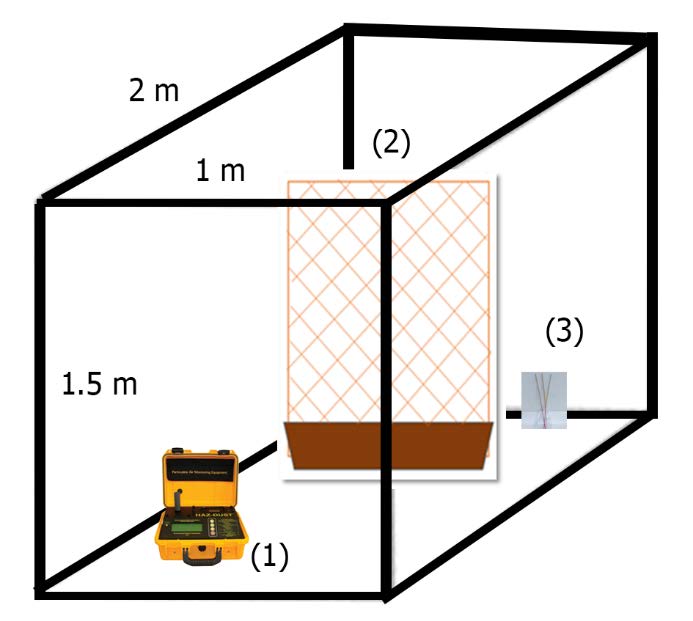
Figure 3. Schematic diagram of the testing chamber used in this experiment (1) PM and air quality sensors, (2): selected plant, (3): particulate matter source.
Air quality measurement
The air quality was monitored every 5 minutes by measuring temperature, relative humidity, and carbon dioxide (CO2) levels using the Dektop Indoor Air Quality CO2 Monitor model DT-802. Additionally, the quantities of particulate matter with a diameter of 2.5 micrometers or less (PM2.5) and particulate matter with a diameter of 10 micrometers or less (PM10) were measured using the HAZ-DUST model EPAM-5000 Environment Particulate Air Monitor.
Statistical analysis
All statistical analyses were conducted using R version 4.3.1 (R Development Core Team. 2021). This study employed the R programming language to explore the relationship between particulate matter deposition and air quality, while considering plant-related factors. The factor correlation analysis matrix was generated using the chart. Correlation function from the Performance Analytics package, providing comprehensive insights into variable interdependencies (Lin et al. 2021).
Non-metric multidimensional scaling (NMDS) analyses were carried out utilizing the MetaMDS functions within the vegan package of R software (Rahman et al., 2022). Dissimilarities were computed based on the Euclidean distance of alterations in air quality parameters, including temperature, % relative humidity, CO2 concentration, PM10 and PM2.5, in conjunction with plant characteristics such as leaf surface, type, average plant leaf area and total leaf area. The fitted vectors, utilizing the envfit routine, depicted the strength of the gradient (arrow length) and the degree of correlation (arrow direction). A positive correlation was indicated by gradients on the same axis.
Analysis of similarities (ANOSIM) was employed to assess differences in temperature, %relative humidity, CO2 concentration, PM10 and PM2.5 changes between samples from Inter-group (between) and Intra-group of plant species, plant types (climbers and shrubs), and leaf surface characters (rough and smooth) using the anosim function of the vegan package. Euclidean Distance was used for distance calculation. In the box plots, the bold horizontal bar represents the median, the bottom of the box indicates the 25th percentile, and the top of the box indicates the 75th percentile, with whiskers extending to the most extreme data point (Zergoun et al., 2019).
RESULTS
Three climbers (Clitoria ternatea L., Thunbergia grandiflora (Roxb. ex Rottler) Roxb, and Passiflora coccinea Aubl) and three shrubs (Tabernaemontana divaricata (dwarf), Lantana camara Linn., and Petunia hybrid) were exposed to incense smoke in a 3 m³ testing chamber. The initial concentration of CO₂ ranged from 7,770.66 to 8,097.54 mg/m³, PM2.5 from 8.80 to 16.18 mg/m³ and PM10 from 9.50 to 19.71 mg/m³. The exposure lasted for 30 minutes at a temperature of 27.9-32.8 °C and relative humidity of 63.6-90.1%. The results showed that the applied plants affected the observed air quality parameters, except for temperature and relative humidity (Figure 4). Nearly all the ornamental plants exhibited a trend of reducing atmospheric carbon dioxide by up to 20% of the initial concentration after within 30 minutes. Additionally, they facilitated the deposition of PM2.5 and PM10, which demonstrated varying degrees of PM deposition depending on the plant species. Petunia hybrid displayed the highest association with PM deposition, while P. coccinea Aubl demonstrated the lowest.
Possible explanations for the observed differences in PM deposition among plant species lie in their diverse leaf morphologies. A correlation analysis incorporating temperature, relative humidity (%RH), CO2, PM10, PM2.5, average leaf area, total leaf area and the correlation analysis result revealed a strong positive correlation between %RH change and PM deposition with total leaf area (Figure 5).
Further support for this conclusion comes from non-metric multidimensional scaling (NMDS) analysis, which effectively visualizes pairwise dissimilarities between objects in a low-dimensional space. Well-separated clusters of points often indicate distinct sub-populations within the data. Visual characterization categorized the leaves of Clitoria ternatea and Tabernaemontana divaricata as smooth, while the remaining species possessed rough leaves (Table 1). Subsequently, alterations in air quality parameters (temperature, %RH, CO2 concentration, PM10, and PM2.5) were analyzed alongside visual plant characteristics such as leaf surface (rough or smooth), plant type (shrub or climber), average leaf area, and total leaf area to interpret patterns and group differences. Ideally, a stress value below 0.2 indicates suitability for two-dimensional representation. Notably, our NMDS analysis (Figure 6) revealed that air quality parameters measured from the ornamental plants clustered based on CO2, PM10, and PM2.5 concentrations, with a stress level of 0.017. Particularly, the data distribution did not exhibit a clear pattern based on leaf surface texture or plant type. Furthermore, the fitted vectors reinforced the strong negative correlation between %RH, PM2.5 and PM10 with total leaf area.
Analysis of Similarities (ANOSIM) is a non-parametric statistical test designed to assess the similarity of two or more groups of samples. This makes it particularly suitable for ecological and environmental studies where multiple treatments can complicate data analysis due to sheer volume. Interpretation hinges on two key elements: the R statistic and its associated P-value. R ranges from -1 to 1, with 0 indicating no difference between groups. Positive values (closer to 1) reflect greater dissimilarities between groups than within them, while negative values (closer to -1) suggest the opposite. Additionally, a small p-value (typically <0.05) denotes statistically significant differences. As depicted in Figure 7, ANOSIM revealed significant differences in air quality parameters between the control and each plant species (R = 0.864, P = 0.001). Similarly, climbers and shrubs exhibited significant differences (R = 0.549,
P = 0.001). Notably, no significant differences were found between plants with rough and smooth leaves.
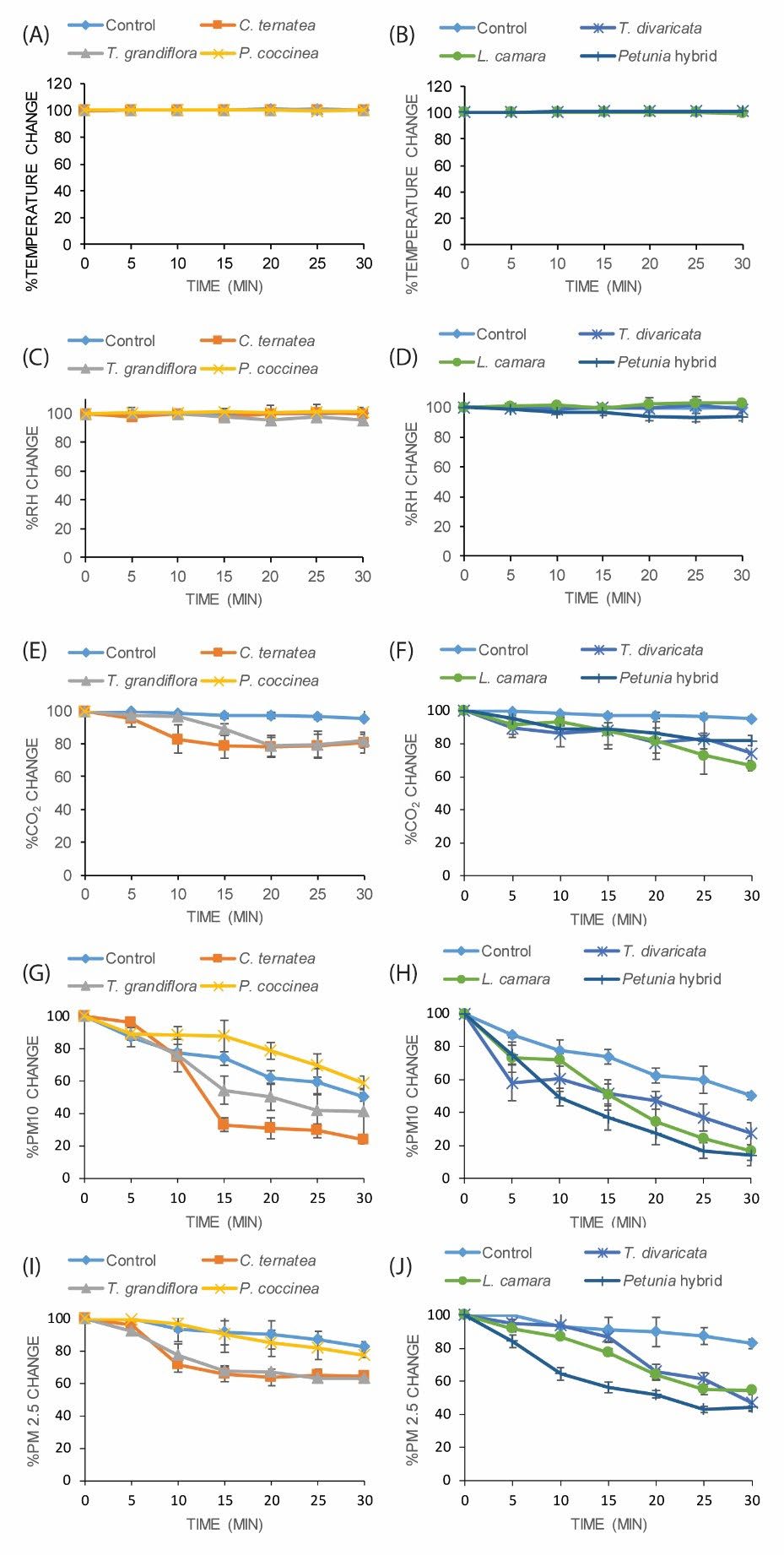
Figure 4. Percentage change in selected air quality parameters induced by ornamental plants. : (left) climbers, (right) shrubs: (A-B) temperature, (C-D) %relative humidity, (E-F) CO2 concentration, (G-H) PM10, (I-J) PM2.5.
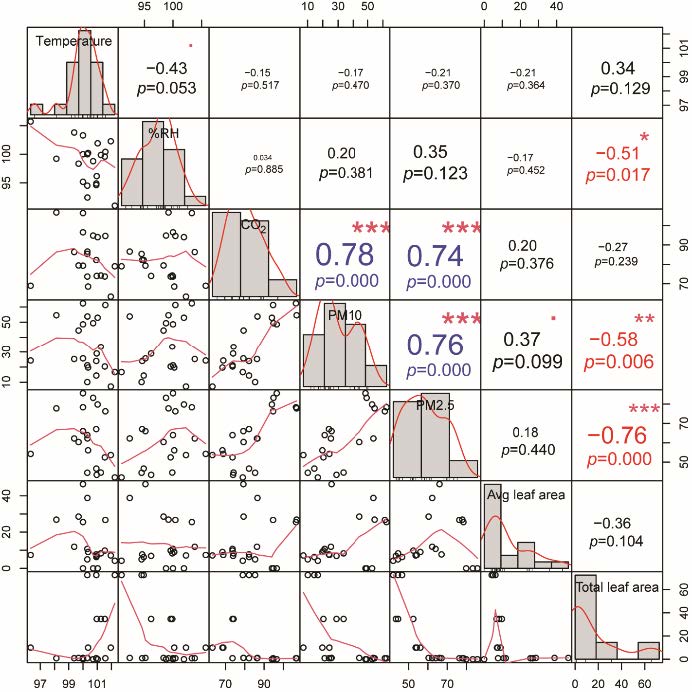
Figure 5. Factor correlation analysis matrix for temperature, %RH, CO2, PM10, PM2.5, average leaf area, and total leaf area. Scatter plots, correlation coefficients (i.e., r values), and data distributions are displayed on the bottom left, top right, and center, respectively. Significance levels: * P < 0.05, ** P < 0.01, *** P <0.001. Red letter indicates significant negative associations and blue letter indicates significant positive associations.
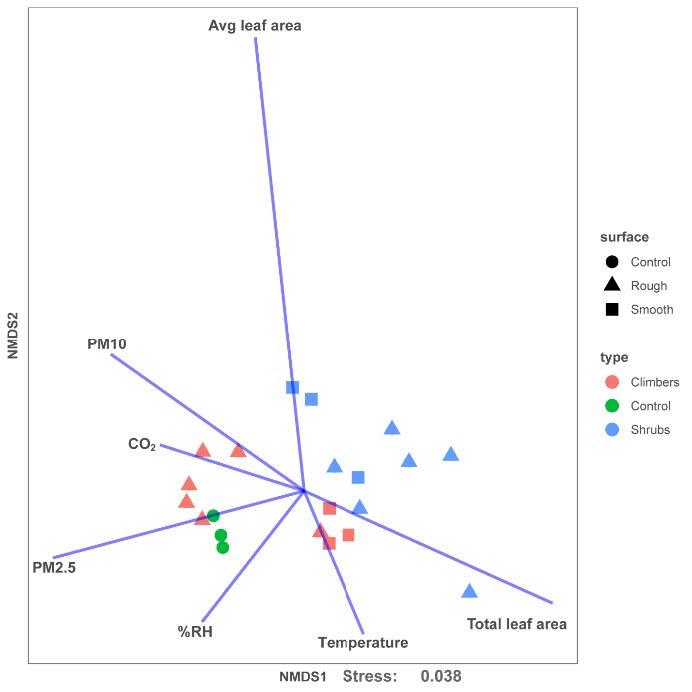
Figure 6. Non-metric multidimensional scaling (NMDS) analyses of selected air quality parameters with plant characters.
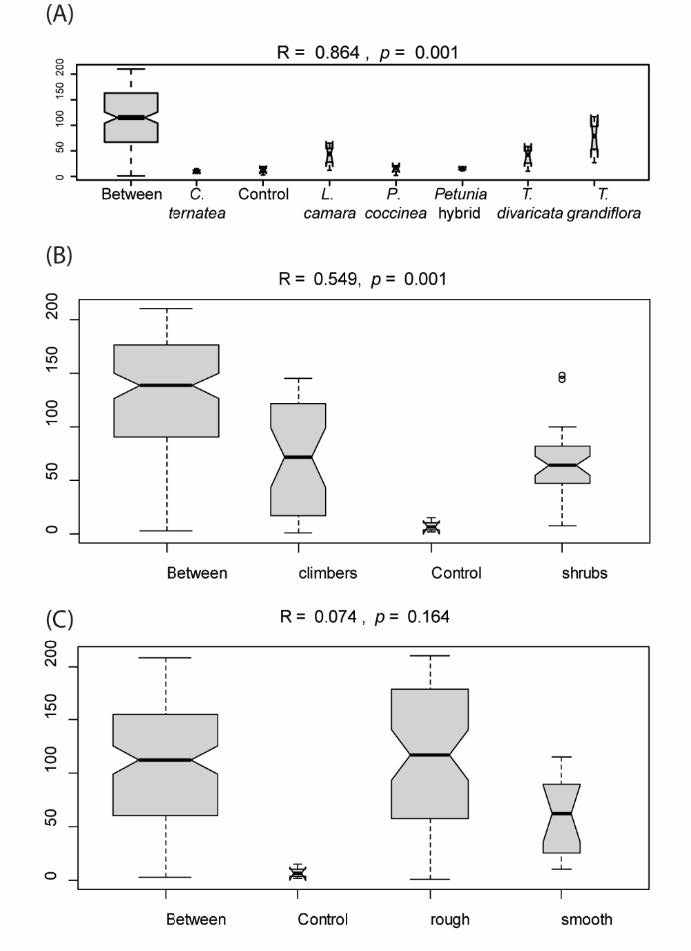
Figure 7. Analysis of similarities (ANOSIM) plot the ranks of distances among sample from Inter-group (between) and Intra-group. (A) Beta distance of plants. (B) Beta distance of control (no plant), climbers and shrubs. (C) Beta distance of control (no plant), rough and smooth leaf.
DISCUSSION
Our findings show some concordance with previous research. Cao et al. (2019) demonstrated the potential of potted ornamental plants, particularly Epipremnum aureum with its rough, grooved leaves and high leaf area, to improve indoor PM2.5 deposition. Notably, our study focused solely on PM deposition. In contrast, other works suggest that certain plants not only aid in PM deposition but also directly absorb it onto their leaves. Gao et al. (2022) observed that PM2.5 dust-retention capacity per unit leaf area significantly correlated with surface roughness due to larger stomata distribution and numerous grooves and bumps. Additionally, Zhang et al. (2018) highlighted the combined influence of leaf characteristics, surface microstructure, and chemical composition/structure of the cuticle layer on PM capture ability. Specifically, leaf surface properties like the variability in individual wax constituents influencing cuticle hydrophobicity, cuticle thickness, and leaf wettability act as key regulatory factors governing PM capture at the leaf level.
This study established a positive correlation between PM deposition and total leaf area, suggesting that larger leaves may enhance air purification potential in ornamental plants. However, visual assessments of leaf surface characteristics were inconclusive. Previous studies have employed advanced techniques like atomic force microscopy or scanning electron microscopy to precisely resolve leaf surface morphology, area, and roughness (Lu et al., 2018; Lee et al., 2021; Gao et al., 2022). While these methods offer valuable insights, their complexity limits accessibility for broader audiences. This study proposes utilizing readily observable leaf characteristics to guide the selection of indoor plants for PM reduction. This approach could benefit non-scientists by extending applicability beyond the specific species covered here or in previous research. Nevertheless, it is crucial to acknowledge the limited number of plant species examined in this study. To confidently validate the use of visual leaf characters, future investigations should encompass a wider range of species with diverse leaf morphologies.
Given the constraints on space in urban environments, vertical greenery systems have emerged as a promising solution for maximizing green coverage (Wang et al., 2016). This study compared the air quality improvement effectiveness of vertical ornamental shrubs and climbers. While the statistical analysis indicated that shrubs exhibited greater efficacy, this finding may be partially attributed to their larger total leaf area. Furthermore, the climber species employed in this study were primarily from the vine group, potentially limiting their overall foliage density. Additionally, certain vines are herbaceous plants, characterized by seasonal foliage fluctuations (Tani and Kudo, 2006). Considering economic efficiency, prioritizing non-deciduous and evergreen plant species for vertical greenery systems could be advantageous.
This study contributes to the understanding of the role of ornamental plants in improving indoor air quality, specifically focusing on PM deposition. Further research with a wider range of plant species and advanced techniques for leaf surface characterization is needed to refine our understanding and develop practical guidelines for utilizing plants for indoor air purification.
CONCLUSION
This study investigated the ability of ornamental plants to improve indoor air quality by examining their impact on PM deposition. Six plant species, encompassing both climbers and shrubs, were exposed to incense smoke in a controlled chamber. The findings revealed that all plants except for temperature and relative humidity significantly affected air quality parameters. Most plants reduced CO2 by up to 20%, and PM deposition varied depending on the species, with Petunia hybrid exhibiting the highest association. Our analysis suggests that total leaf area plays a crucial role in PM deposition, while visual assessment of leaf surface texture yielded inconclusive results. This study highlights the potential of ornamental plants for indoor air purification and emphasizes the need for further research to explore a wider range of species and refine our understanding of influencing factors.
ACKNOWLEDGEMENTS
I am grateful to Ms. Suthinee Hathaisaensuksom and Ms. Siwaporn Kamthip for their invaluable assistance in data collection and equipment preparation. I also extend my sincere thanks to the Faculty of Science and Technology, Chiang Mai Rajabhat University, for providing the necessary instruments, which significantly facilitated the research.
AUTHOR CONTRIBUTIONS
Pamon Pumas was solely responsible for the research design, conducting all experiments, data analysis, and manuscript writing.
CONFLICT OF INTEREST
The authors declare that they hold no competing interests.
REFERENCES
Abbasgholizadeh, R., Eslami, A.R., and Kaviani, B. 2021. Growth rate prediction of ornamental trees using regression functions in urban landscapes. Chiang Mai University Journal of Natural Sciences. 20(4): e2021080.
Bandehali, S., Miri, T., Onyeaka, H., and Kumar, P. 2021. Current state of indoor air phytoremediation using potted plants and green walls. Atmosphere. 12(4): 473.
Cao, Y., Li, F., Wang, Y., Yu, Y., Wang, Z., Liu, X., and Ding, K. 2019. Assisted deposition of PM2. 5 from indoor air by ornamental potted plants. Sustainability. 11(9): 2546.
Das, S. and Prasad, P. 2012. Particulate matter capturing ability of some plant species: implication for phytoremediation of particulate pollution around Rourkela Steel Plant, Rourkela, India. Nature, Environment and Pollution Technology. 11(4): 657-665.
Dzhambov, A.M., Lercher, P., Browning, M.H., Stoyanov, D., Petrova, N., Novakov, S., and Dimitrova, D.D. 2021. Does greenery experienced indoors and outdoors provide an escape and support mental health during the COVID-19 quarantine?. Environmental Research. 196: 110420.
Gao, Z., Qin, Y., Yang, X., and Chen, B. 2022. PM10 and PM2.5 Dust-retention capacity and leaf morphological characteristics of landscape tree species in the Northwest of Hebei Province. Atmosphere. 13(10): 1657.
Khaslan, Z., Nadzir, M.S.M., Johar, H., Siqi, Z., Sulong, N.A., Mohamed, F., Majumdar, S., Suris, F.N.A., Hawari, N.S.S.L., Borah, J., and Gee, M.O.C., 2024. Utilizing a low-cost air quality sensor: Assessing air pollutant concentrations and risks using low-cost sensors in selangor, Malaysia. Water, Air, and Soil Pollution. 235(4): 229.
Kawichai, S., Prapamontol, T., Cao, F., Liu, X.Y., Song, W.H., Kiatwattanacharoen, S., and Zhang, Y.L. 2021. Significant contribution of C3—type forest plants’ burning to airborne PM2.5 pollutions in Chiang Mai Province, Northern Thailand. Chiang Mai University Journal of Natural Sciences. 20(4): e2021088.
Kawichai, S., Prapamontol, T., Chantara, S., Kanyanee, T., Wiriya, W., and Zhang, Y.L. 2020. Seasonal variation and sources estimation of PM2.5 bound pahs from the ambient air of Chiang Mai City: An all-year-round study in 2017. Chiang Mai Journal of Science. 47(5): 958-972.
Kelly, F.J. and Fussell, J.C. 2019. Improving indoor air quality, health and performance within environments where people live, travel, learn and work. Atmospheric Environment. 200: 90-109.
Lee, J.K., Kim, D.Y., Park, S.H., Woo, S.Y., Nie, H., and Kim, S.H. 2021. Particulate matter (PM) adsorption and leaf characteristics of ornamental sweet potato (Ipomoea batatas L.) cultivars and two common indoor plants (Hedera helix L. and Epipremnum aureum Lindl. & Andre). Horticulturae. 8(1): 26.
Lin, T.C., Krishnaswamy, G., and Chi, D.S. 2008. Incense smoke: Clinical, structural and molecular effects on airway disease. Clinical and Molecular Allergy. 6(1): 1-9.
Liu, F., Yan, L., Meng, X. and Zhang, C. 2022. A review on indoor green plants employed to improve indoor environment. Journal of Building Engineering. 53: 104542.
Lu, S., Yang, X., Li, S., Chen, B., Jiang, Y., Wang, D. and Xu, L. 2018. Effects of plant leaf surface and different pollution levels on PM2.5 adsorption capacity. Urban Forestry & Urban Greening. 34: 64-70.
Ma, J. 2022. Interaction with nature indoor: Psychological impacts of houseplants care behaviour on mental well-being and mindfulness in Chinese adults. International Journal of Environmental Research and Public Health. 19(23): 15810.
Manisalidis, I., Stavropoulou, E., Stavropoulos, A., and Bezirtzoglou, E. 2020. Environmental and health impacts of air pollution: A review. Frontiers in Public Health. 8: 14.
Panepinto, D., Riggio, V.A., and Zanetti, M. 2021. Analysis of the emergent climate change mitigation technologies. International Journal of Environmental Research and Public Health. 18(13): 6767.
Perini, K. and Rosasco, P. 2013. Cost–benefit analysis for green façades and living wall systems. Building and Environment. 70: 110-121.
Pun, V.C., Kazemiparkouhi, F., Manjourides, J., and Suh, H.H. 2017. Long-term PM2.5 exposure and respiratory, cancer, and cardiovascular mortality in older US adults. American Journal of Epidemiology. 186(8): 961-969.
R Core Team. 2021. R: A language and environment for statistical computing. R Foundation for Statistical Computing, Vienna, Austria.
Rabuan, U., Mohd Nadzir, M.S., Abdullah Sham, S.Z., Izzati Wan Shaiful Bahri, S.B., Borah, J., Majumdar, S., Lei, T.M., Md Ali, S.H., A Wahab, M.I., and Mohd Yunus, N.H., 2023. Evaluations of Low-cost Air Quality Sensors for Particulate Matter (PM2.5) under Indoor and Outdoor Conditions. Sensors and Materials. 35(8): 2881-2895.
Rahman, I.U., Hart, R.E., Ijaz, F., Afzal, A., Iqbal, Z., Calixto, E.S., Abd_Allah, E.F., Alqarawi, A.A., Hashem, A., Al-Arjani, A.B.F., and Kausar, R. 2022. Environmental variables drive plant species composition and distribution in the moist temperate forests of Northwestern Himalaya, Pakistan. PloS one. 17(2): 0260687.
Saleem, I., Ali, Z., and Hussain, A. 2022. Assessment of indoor air pollutants exposure in hair salons of Lahore. Chiang Mai University Journal of Natural Sciences. 21(4): e2022065.
Tani, T. and Kudo, G. 2006. Seasonal pattern of leaf production and its effects on assimilation in giant summer-green herbs in deciduous forests in northern Japan. Botany. 84(1): 87-98.
Treesubsuntorn, C., Setiawan, G.D., Permana, B.H., Citra, Y., Krobthong, S., Yingchutrakul, Y., Siswanto, D., and Thiravetyan, P. 2021. Particulate matter and volatile organic compound phytoremediation by perennial plants: Affecting factors and plant stress response. Science of the Total Environment. 794: 148779.
Wang, C., Er, S.S., and Abdul-Rahman, H. 2016. Indoor vertical greenery system in urban tropics. Indoor and Built Environment. 25(2): 340-356.
World Health Organization, 2021. WHO global air quality guidelines: Particulate matter (PM2.5 and PM10), ozone, nitrogen dioxide, sulfur dioxide and carbon monoxide. World Health Organization.
Zergoun, Y., Guezoul, O., Sekour, M., Bouras, N., and Holtz, M.D. 2019. Acridid (Orthoptera: Caelifera) diversity in agriculture ecosystems at three locations in the Mzab valley, Septentrional Sahara, Algeria. Journal of Insect Biodiversity. 9(1): 18-27.
Zhang, W., Zhang, Z., Meng, H., and Zhang, T. 2018. How does leaf surface micromorphology of different trees impact their ability to capture particulate matter?. Forests. 9(11): 681.
OPEN access freely available online
Natural and Life Sciences Communications
Chiang Mai University, Thailand. https://cmuj.cmu.ac.th
Pamon Pumas*
Department of Environmental Science, Faculty of Science and Technology, Chiang Mai Rajabhat University, Chiang Mai 50180, Thailand.
Corresponding author: Pamon Pumas, E-mail: pamon_pum@cmru.ac.th
Total Article Views
Editor: Sirasit Srinuanpan,
Chiang Mai University, Thailand
Article history:
Received: March 23, 2024;
Revised: May 6, 2024;
Accepted: May 20, 2024;
Online First: June 7, 2024

